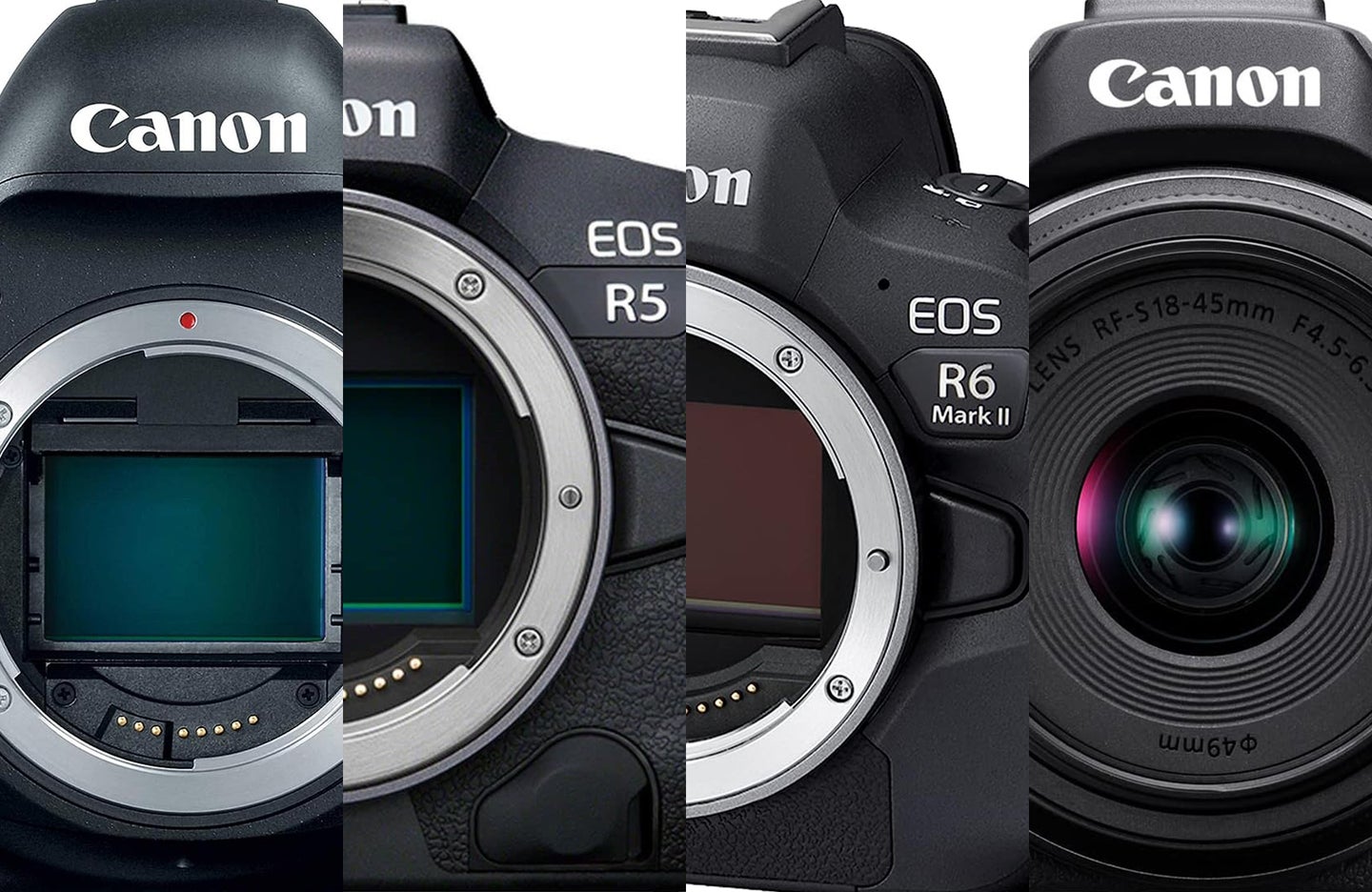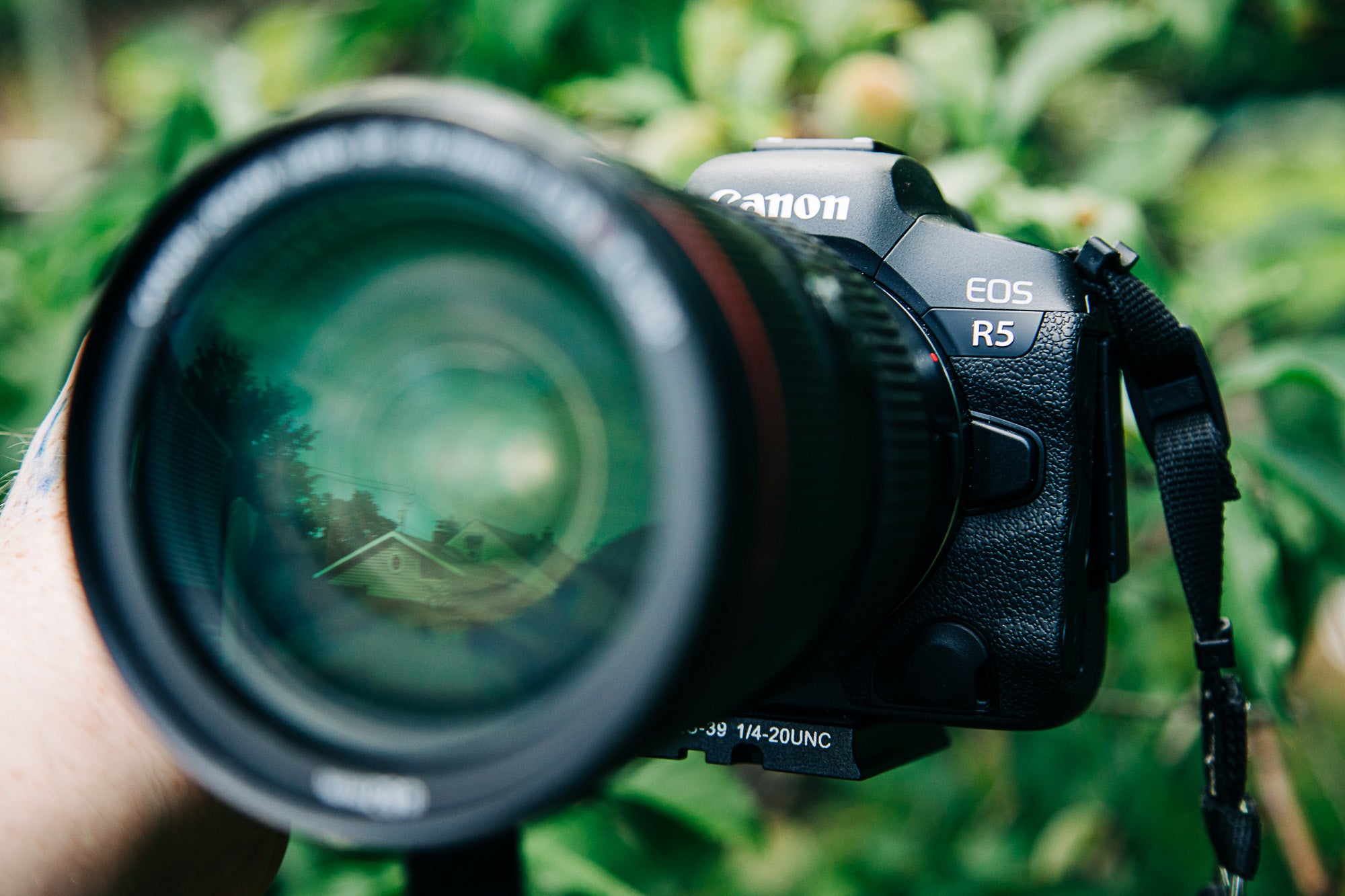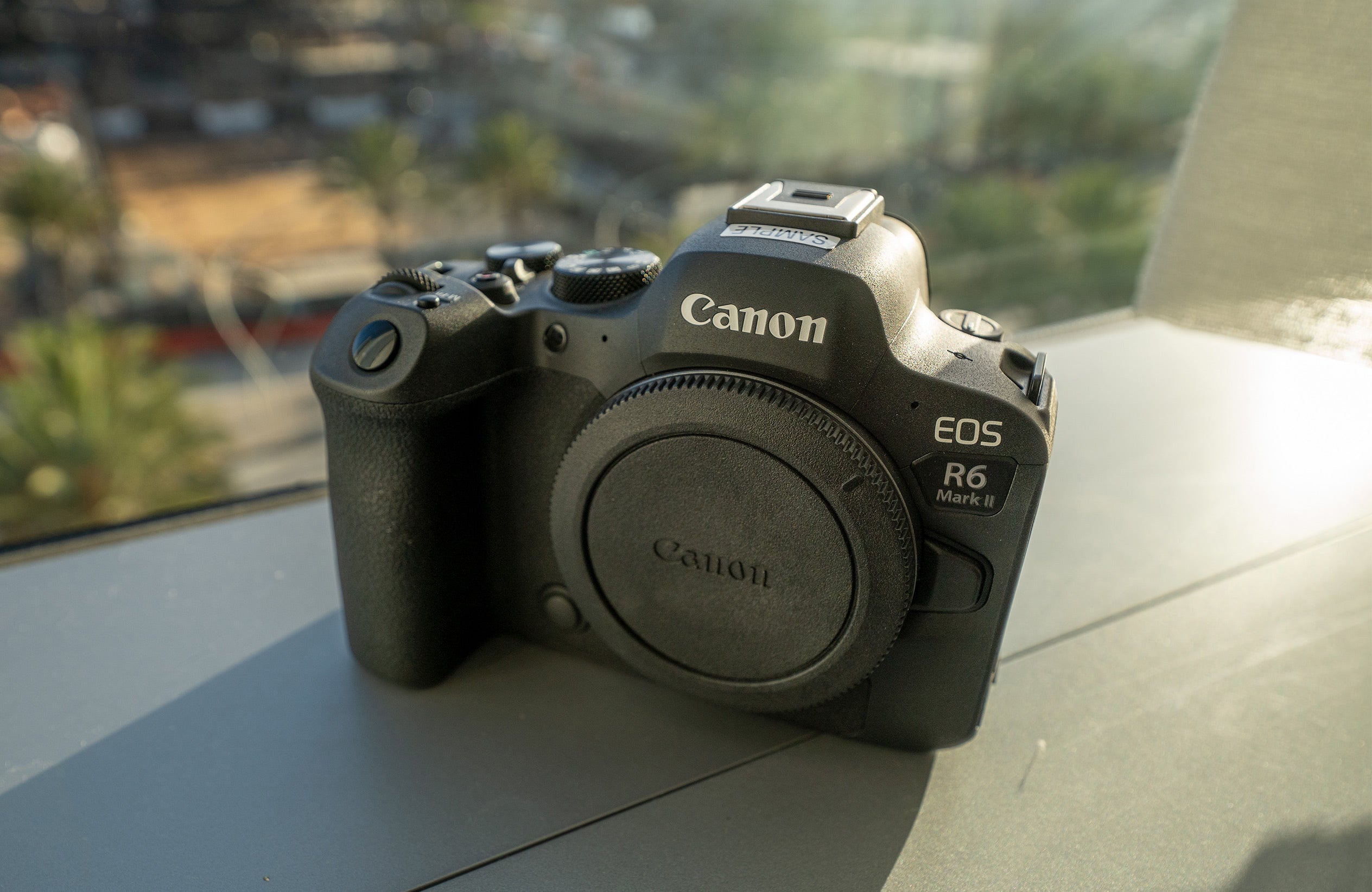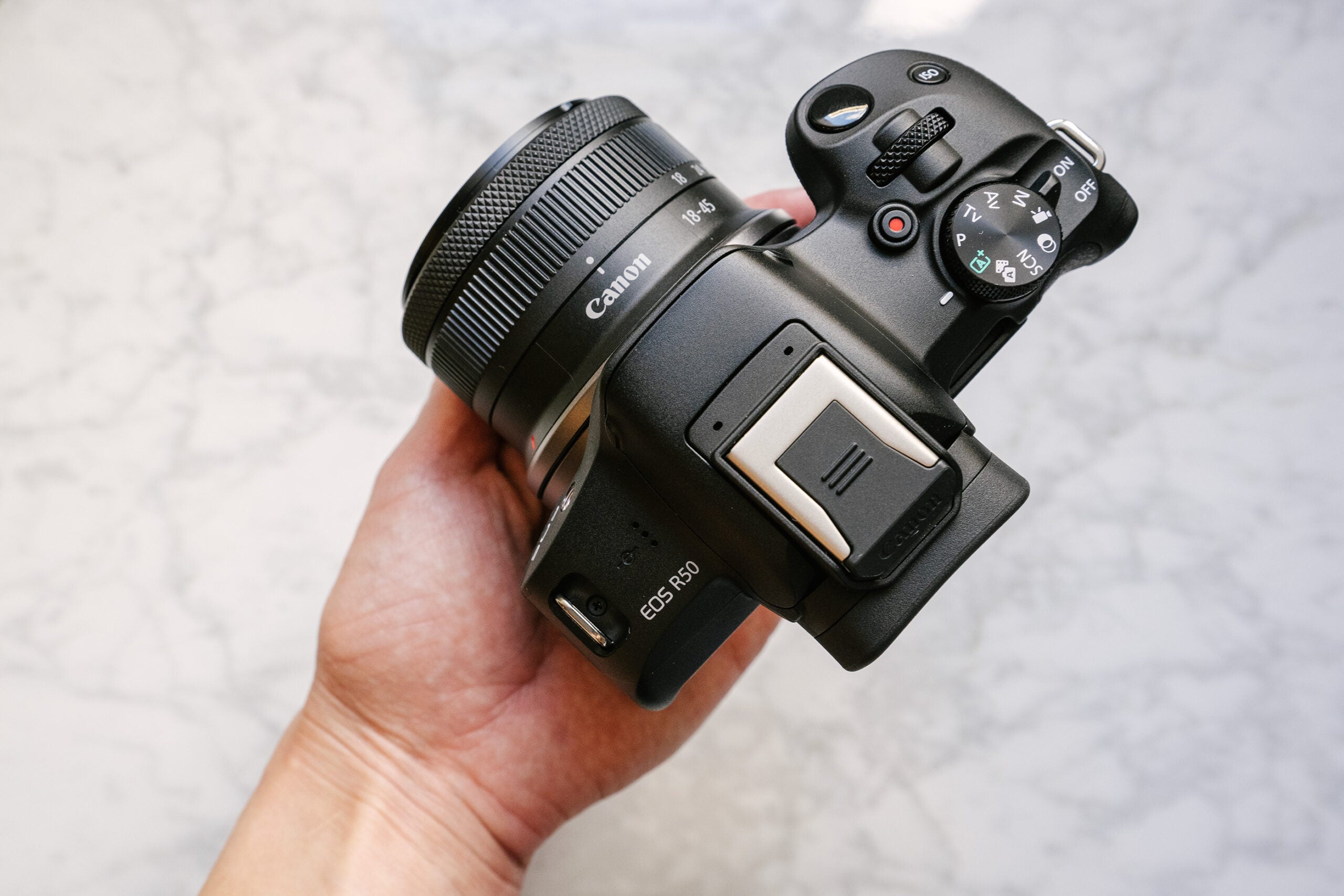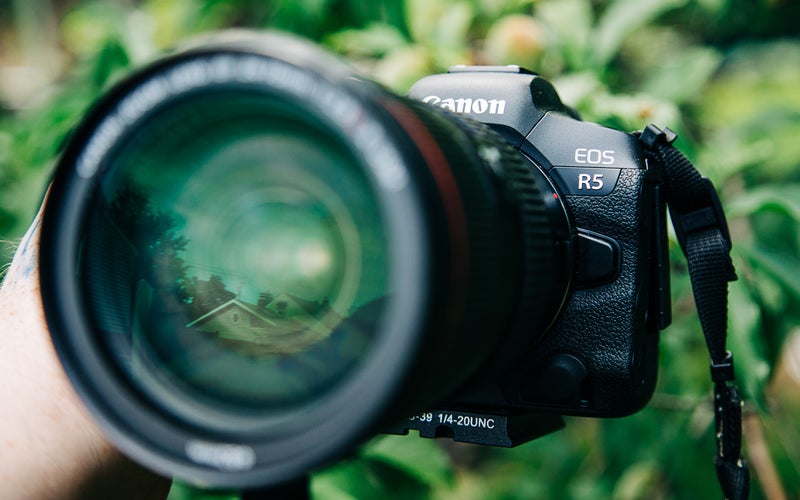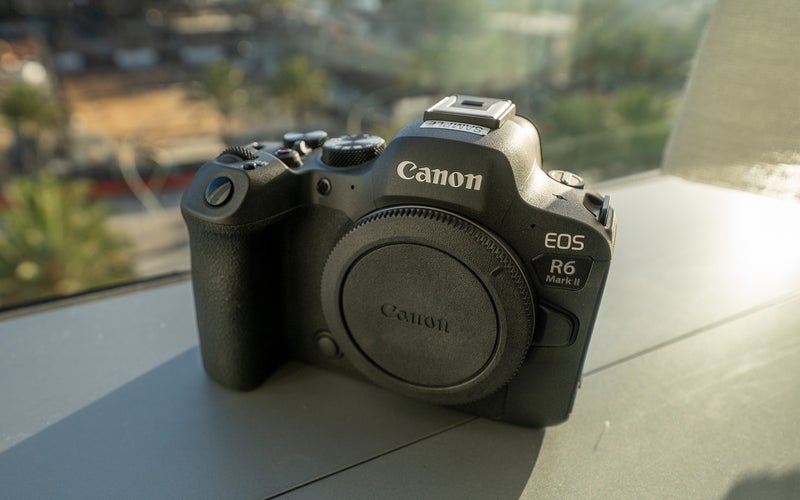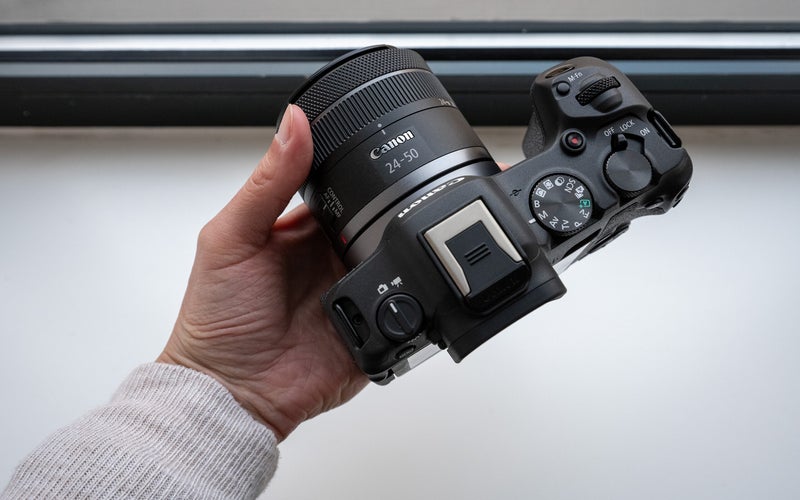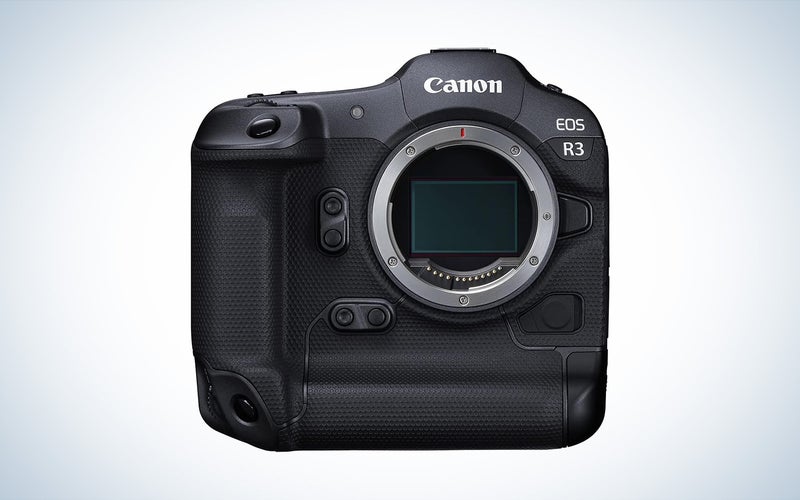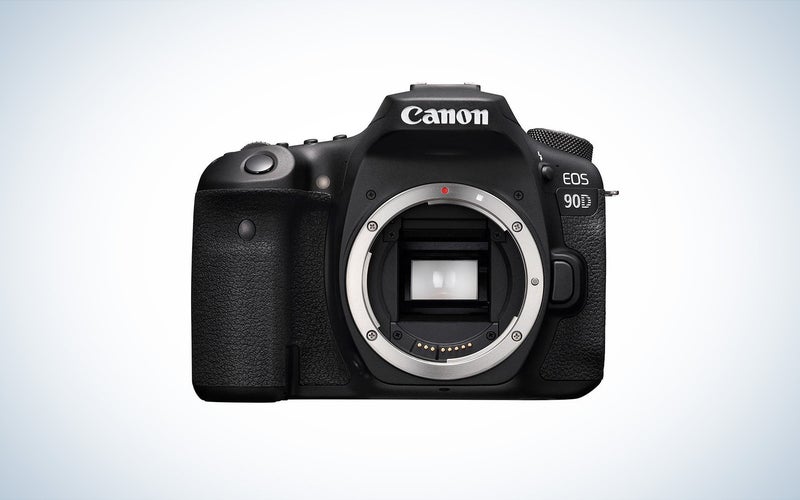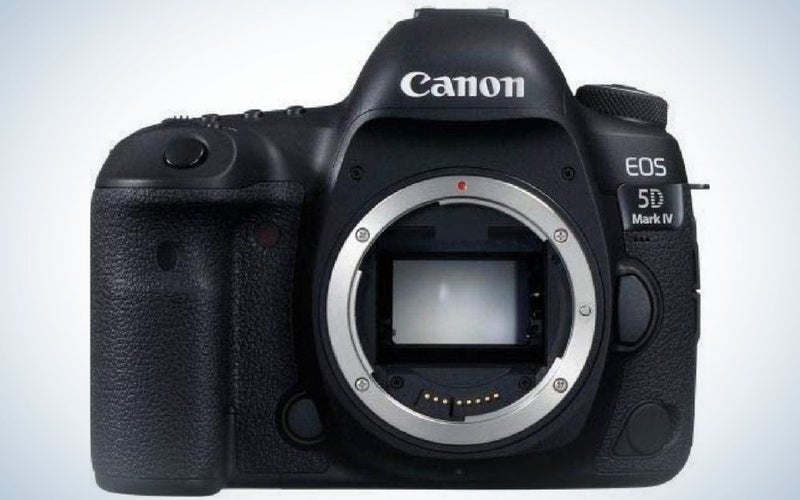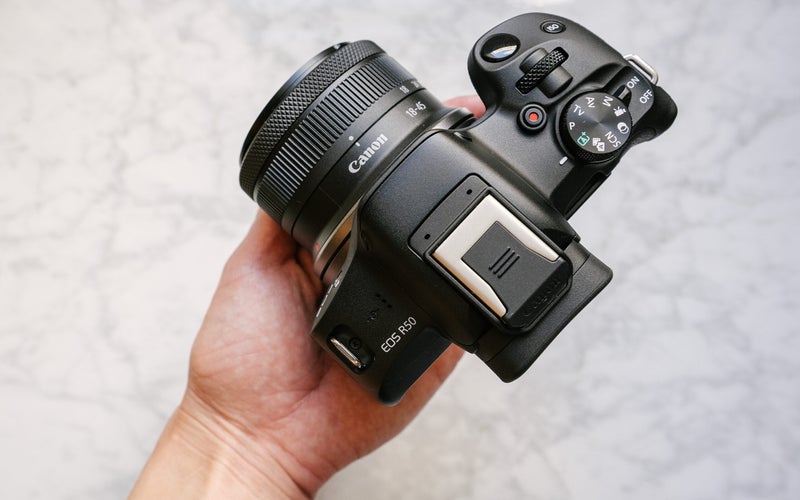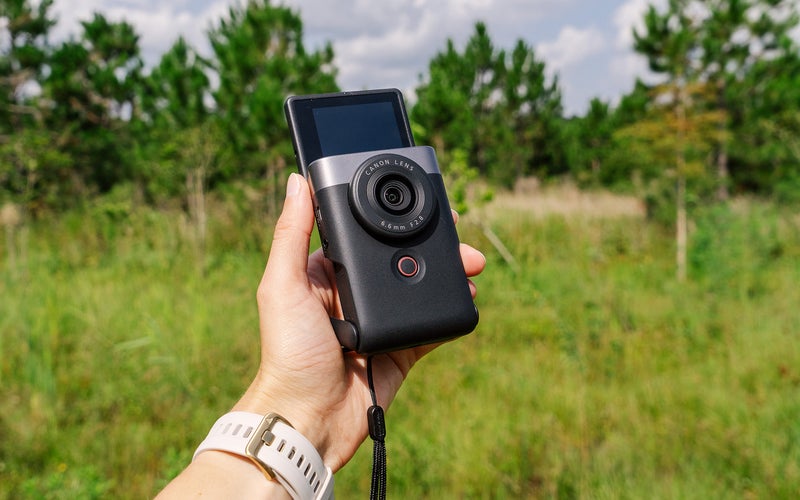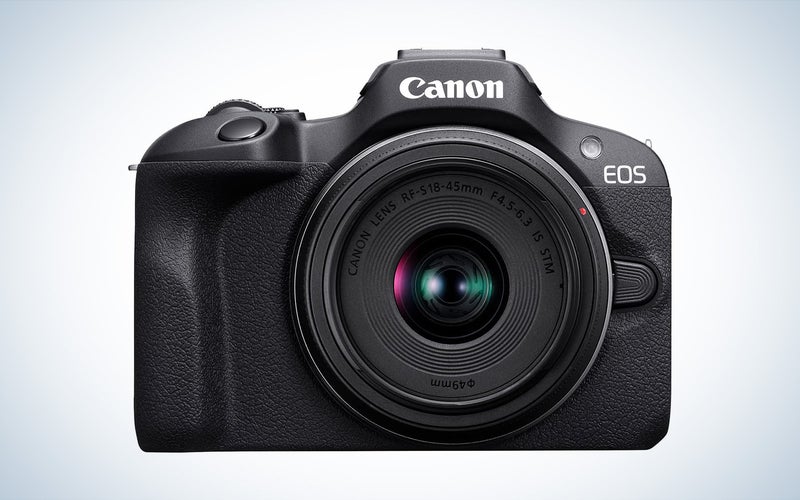We may earn revenue from the products available on this page and participate in affiliate programs. Learn more ›
Canon cameras have been some of the most dominant and prolific image-making devices for more than half a century. The company released its first digital camera, the EOS D30, back in 2000 when most photographers were still loyal to their film bodies, and digital was a novel concept. In 2020, Canon held nearly half of the global digital camera market. The company’s current lineup has options aimed at every level of photographer, from budding beginners to seasoned pros. While options are good, the wide selection of Canon cameras can be difficult to navigate, so here are some things to consider before jumping full-force into the best Canon cameras.
- Best full-frame mirrorless camera: Canon EOS R5
- Best mid-range mirrorless camera: Canon EOS R6 Mark II
- Best entry-level full-frame mirrorless camera: Canon EOS R8
- Best for sports photography: Canon EOS R3
- Best mid-range Canon DSLR: Canon EOS 90D
- Best professional Canon DSLR: Canon EOS 5D Mark IV
- Best for beginners: Canon EOS R50
- Best for beginner vloggers: Canon PowerShot V10
- Best budget: Canon EOS R100
How we chose the best Canon cameras
The writers and editors at Pop Photo have decades of experience with every major camera manufacturer, including Canon. We have hands-on experience with most of the cameras included here, along with most other Canon cameras, which guided our decisions. We also relied on a mix of editorial reviews and user feedback.
When selecting the best Canon cameras, we aimed to choose options suitable for a variety of photographers and videographers, from beginners to professionals. As a result, we considered a range of features and specs, including overall image quality, burst shooting abilities, video capabilities, build quality, and usability.
The best Canon cameras: Reviews & Recommendations
Canon’s camera options span the full range from beginner-friendly to pro-level models. No matter your price point or what you are hoping to use your camera for, one of these cameras is sure to meet your needs.
Best full-frame mirrorless camera: Canon EOS R5
Stan Horaczek
Specs
- Resolution: 45 megapixels
- Sensor size: Full-frame
- Lens mount: Canon RF
- Image stabilization: Sensor-Shift, 5-Axis
- Memory card slots: Slot 1: CFexpress Type B, Slot 2: SD/SDHC/SDXC (UHS-II)
- Weight: 1.62 pounds
- Dimensions: 5.43 x 3.84 x 3.46 inches
Pros
- Superb image quality
- Advanced focus tracking
- Durable build quality
- Capable of recording 8K video
Cons
- Overheating may be an issue at the highest video quality
The Canon EOS R5 is the brand’s flagship mirrorless camera, at least for the moment. It pairs its ample 45-megapixel resolution with a powerful Digic X image processor. As a result, it boasts an ISO range of 100-51200 (expandable to 1024001), high-speed shooting up to 12 fps with a mechanical shutter, and 20 fps with the electronic silent shutter. It features dual memory card slots and promises fast, accurate AF with its dual-pixel CMOS AF and subject tracking for human and animal subjects.
If you are looking for a pro-level camera inside a compact mirrorless camera body, look no further. It even has robust video capabilities that top out at 8K, though that’s not its primary purpose. If you want truly pro video features, you’ll want to upgrade to a Canon cinema camera. To learn more about the Canon EOS R5, check out our full review.
Best mid-range mirrorless camera: Canon EOS R6 Mark II
Abby Ferguson
Specs
- Resolution: 24.2 megapixels
- Sensor size: Full-frame
- Lens mount: Canon RF
- Image stabilization: Sensor-Shift, 5-Axis
- Memory card slots: Dual slot: SD/SDHC/SDXC (UHS-II)
- Weight: 1.3 pounds (body only)
- Dimensions: 5.4 x 3.9 x 3.5 inches
Pros
- Impressive autofocus abilities
- Good noise handling at high ISOs
- Fast burst shooting is ideal for action
- Excellent video quality
Cons
- Relatively low resolution isn’t for everyone
If you want a highly capable camera but don’t need something as advanced as the R5, the R6 Mark II is a fantastic choice. It’s a camera built for action, thanks to its whopping 40 fps when using the electronic shutter. Or you can bump down to 30 fps to record action that happens half a second before you press the shutter. It also borrows the advanced autofocus abilities of the twice as expensive R3. The Auto Subject Tracking mode makes it easy to nail focus on shots without fussing with loads of settings and menu options.
For video shooters, you’ll have access to 6K external recording, 4K 60p full-width internal recording, or full HD at 150 fps. And the Detect Only AF keeps focus on your subject even if they come in and out of the frame, resulting in smoother videos. Its overall image quality is also superb, with impressive noise handling at higher ISOs. This camera is an impressive option for hybrid shooters who want a solid all-arounder.
To read more about the R6 Mark II, check out our review.
Best entry-level full-frame mirrorless camera: Canon EOS R8
Abby Ferguson
Specs
- Resolution: 24.2 megapixels
- Sensor size: Full-frame
- Lens mount: Canon RF
- Image stabilization: Digital, 5-Axis (video only)
- Memory card slots: Single slot: SD/SDHC/SDXC (UHS-II)
- Weight: 1 pound
- Dimensions: 5.22 x 3.39 x 2.76 inches
Pros
- Reasonably priced
- Class-leading autofocus
- Compact and lightweight
- Fast burst shooting
Cons
- No joystick for adjusting focus points
Canon’s EOS R8 is an impressive camera for those who are looking to upgrade to a full-frame mirrorless camera. Its reasonable price doesn’t mean that you miss out on refined features. As with other Canon cameras, it borrows advanced, AI-driven autofocus abilities from much more expensive models, resulting in class-leading autofocus. It is fast, responsive, highly accurate, and also easy to use without messing with settings.
Canon did away with the mechanical shutter in the R8. But the electronic shutter is capable of a speedy 40 fps and pre-shooting support, which is ideal for capturing fast action. It can record up to 4K 60p video and offers Vertical Movie Mode for those who share their videos on social media. And the image quality is excellent, with impressive dynamic range even in jpeg files. It’s an easy camera to use and get used to, making it a fantastic choice for beginners wanting a full-frame camera.
Head over to our review to learn more about the EOS R8.
Best for sports photography: Canon EOS R3
Canon
- Resolution: 24.1 megapixels
- Sensor size: Full-frame
- Lens mount: Canon RF
- Image stabilization: Sensor-Shift, 5-Axis
- Memory card slots: Slot 1: CFexpress Type B, Slot 2: SD/SDHC/SDXC (UHS-II)
- Weight: 2.2 pounds
- Dimensions: 5.9 x 5.6 x 3.4 inches
Pros
- Fantastic AF performance
- Very comfortable to hold thanks to the integrated vertical grip
- Long battery life
- Fast memory card slots
- Networking capabilities
- Large viewfinder
- Excellent layout with lots of tactile controls
- Fast capture speeds
Cons
- Eye Control may be of limited usefulness
- Expensive
- Heavy
If you’re shooting heavy-duty action photography, this is the Canon camera you want on your back. Built for pro sports shooters, this full-sized camera has a built-in vertical grip like the flagship 1-series DSLRs that came before it. While that grip makes it heavier than a typical body, it also provides ample hold and nice balance when using larger zoom lenses. I very much enjoy how the shaped grip fits my hand in both vertical and horizontal orientations.
The design has other positive aspects, too. You’ll find a ton of tactile buttons and controls, including a control wheel, a joystick, and even a touch-sensitive pad that allows you to quickly zip around an image when you’re reviewing it. It’s surprisingly handy.
The half-inch viewfinder offers more than 5.7 million pixels of resolution. It’s big, bright, and fast, which is crucial for shooting action. It has a pair of card slots, including one that fits CFexpress cards. Plus, it offers the high-speed networking capabilities that high-end pro sports shooters require for delivering images instantly.
When it comes to image quality, the 24.1-megapixel resolution seems a bit paltry when compared to other high-end models, but this body is built for speed. It can capture 12 fps with the mechanical shutter or 30 fps with the electronic shutter.
Yes, this is an expensive piece of gear, but it’s built for work, and it does a great job. You may not get much use out of the clever Eye Control system, which focuses by detecting where you’re looking in the scene. But, it is effective once you get used to it. There’s also a learning curve that comes with the camera, so you’ll need to do some tweaking and practicing to get the most out of it. Once you’ve put in the work, however, this is one of the best sports cameras available full-stop. I’ve also shot weddings, portraits, and pretty much everything else with this infinitely capable body.
Best mid-range Canon DSLR: Canon EOS 90D
Canon
Specs
- Resolution: 32.5 megapixels
- Sensor size: APS-C
- Lens mount: Canon EF-S
- Image stabilization: Digital (video only)
- Memory card slots: Single slot: SD/SDHC/SDXC (UHS-II)
- Weight: 1.54 pounds
- Dimensions: 5.54 x 4.13 x 3.02 inches
Pros
- Quality optical viewfinder
- 4K video recording
- Excellent image quality in raw and jpeg files
- Durable build quality
Cons
- Digital IS for video results in heavy crop
The Canon EOS 90D is one of the best APS-C DSLRs that Canon currently offers. It can shoot 10 fps, offers a 45-point all cross-type AF system, can shoot 4K UHD 30P video, and features Wi-Fi and Bluetooth compatibility. Face and eye detection while shooting in live view is excellent, and the burst shooting capabilities make it great for capturing fast-moving action. This is a versatile DSLR for advanced amateur shooters who are interested in capturing stills and video. Canon has been refining this line for more than a decade, and that experience shows here.
Best professional Canon DSLR: Canon EOS 5D Mark IV
Canon
Specs
- Resolution: 30.4 megapixels
- Sensor size: Full-frame
- Lens mount: Canon EF
- Image stabilization: None
- Memory card slots: Slot 1: SD/SDHC/SDXC (UHS-I), Slot 2: CompactFlash (UDMA 7)
- Weight: 1.76 pounds
- Dimensions: 5.9 x 4.6 x 3 inches
Pros
- Extremely durable build quality
- Superb image quality
- Excellent autofocus performance
- Yeas-to-use touchscreen interface
Cons
- 1.64x crop in 4K video
- Fixed rear screen is limiting
Although the Canon 5D Mark IV was released five years ago, it remains a popular full-frame DSLR among professional photographers. It provides an ISO range of 100-32000 (expandable to 50-102400) and shoots 4K video at 30p or 24p. It features excellent dual-pixel CMOS AF, an LCD touchscreen monitor, and a 7 fps burst mode.
This was the first 5D camera to feature Wi-Fi capability, which is great for photographers who need to share images shortly after they are shot. It is an excellent tool for high-level enthusiasts or professionals looking for a lighter setup than the bulky EOS 1D-X. The Mark IV is also built like a tank, so you don’t have to worry about it crapping out during an intense shoot.
Best for beginners: Canon EOS R50
Abby Ferguson
Specs
- Resolution: 24.2 megapixels
- Sensor size: APS-C
- Lens mount: Canon RF
- Image stabilization: None
- Memory card slots: Single slot: SD/SDHC/SDXC
- Weight: 13.2 ounces
- Dimensions: 4.6 x 3.4 x 2.7 inches
Pros
- Lots of beginner-friendly features
- Very compact and lightweight
- Results in attractive photos without editing
- Uncropped 4K video
Cons
- Limited controls aren’t ideal for those wanting to advance their skills
- No in-body stabilization
Canon released the EOS R50 in the spring of 2023, and it is clear the company designed this camera for true beginners. The menu system has been paired down to the bare necessities, making it very easy to learn how to use. And it’s a tiny camera, making it ideal for family snapshots or travel. And it is compatible with all RF lenses, so you can opt for quality glass.
The R50 features a new A+ auto mode, which makes the camera act like your smartphone. If it detects backlighting or a high-contrast scene, the camera will take multiple photos and merge them into an already processed file. You don’t need to spend any time editing in order to get an attractive image. The Creative Bracketing and Creative Assist modes also help you get excellent results with minimal work. The R50 is capable of manual exposure, but Canon optimized it for automatic shooting, meaning it won’t be the best choice for those who want something to grow into. But if you want a basic, easy-to-use camera for your family or travel images, this is an impressive little device.
Head over to our review to learn more about this beginner-friendly mirrorless camera.
Best for beginner vloggers: Canon PowerShot V10
Abby Ferguson
Specs
- Resolution: 13.1 megapixels
- Sensor size: 1-inch
- Lens mount: N/A
- Image stabilization: Digital
- Memory card slots: Single slot: microSD
- Weight: 7.4 ounces
- Dimensions: 3.5 x 2.5 x 1.4 inches
Pros
- Extremely tiny
- Built-in stand is handy
- Affordable
- Very simple to use
Cons
- No raw photos
- Built-in lens isn’t for everyone
If you are just entering the vlogging or content creation world, the PowerShot V10 will be a useful tool. The camera marked a new lineup for Canon and is a true point-and-shoot-style device. It is incredibly simple to use, with very limited menu items and settings. Canon designed it to be an easy transition from a smartphone, and indeed, it feels rather similar. You’ll be able to pick it up and instantly get to recording. The built-in lens also means that you don’t need to worry about buying or changing lenses.
The built-in stand on the V10 is very useful, but it also offers a tripod socket on the bottom for when you want more height. It’s capable of 4K 30p video or Full HD up to 60 fps. And turning the camera on its side easily switches to vertical video for social media content. It can also take still photos, though only in automatic mode, and it only results in jpeg files. But for those who want to focus on video as they jump into content creation, the V10 is a good choice.
You can read our full review to learn more about the PowerShot V10.
Best budget: Canon EOS R100
Canon
Specs
- Resolution: 24.1 megapixels
- Sensor size: APS-C
- Lens mount: Canon RF
- Image stabilization: None
- Memory card slots: Single slot: SD/SDHC/SDXC
- Weight: 12.6 ounces
- Dimensions: 4.6 x 3.4 x 2.7 inches
Pros
- Very affordable for an interchangeable lens camera
- Extremely tiny
- Very good image quality
- Easy to use
Cons
- No touchscreen
The EOS R100 serves as a replacement Canon camera for the Rebel T7. As evidenced by the approachable price, it is a beginner-friendly camera that’s easy to learn and use. It provides access to Canon’s Scene Intelligent Auto, which helps in creating properly exposed images even in challenging lighting situations. And it features a true viewfinder, Eye Detect autofocus, and a 24.1-megapixel sensor that results in great image quality. And it’s the smallest EOS R camera to date, making it ideal for travel.
The R100 is capable of cropped 4K 24p or full-width Full HD video at 60p with Movie Digital IS for smoothing out motion somewhat. Despite the video capabilities, Canon primarily intends this camera for still photos, as the fixed rear screen demonstrates. It also doesn’t offer touchscreen functionality, which may be frustrating for some. But for the price, this little camera is hard to beat, especially for beginners or those wanting a simple, easy-to-use camera that allows for some room to grow.
Things to consider when choosing the best Canon cameras for you
Choosing a camera from any brand can be a tricky endeavor. While you want to choose a camera that will let you grow and adapt to your skills as you improve, overkill is a real possibility. For instance, a high-end, pro-level camera like EOS R3 has lots of capabilities, but it’s also bulky and expensive. And by the time you grow into its advanced features, new technology may have made it outdated. Considering the features and specifications below will help you narrow down which level of camera is right for you.
Mirrorless versus DSLR
While mirrorless cameras have done a lot to eclipse DSLRs in recent years, Canon still sells a number of extremely capable and worthwhile DSLR models. Canon DSLRs like the EOS 5D Mark IV and the EOS-1D X remain favored tools of wedding photographers, sports shooters, and photojournalists. Canon’s DSLRs are built to take a beating, which is one of the reasons that many pros still use them. Although they are heavier and bulkier than Canon’s mirrorless cameras, they typically have increased battery life and will withstand more abuse. Canon’s DSLRs are compatible with EF mount lenses.
Although there may be advantages to DSLRs, it is worth noting that many companies, Canon included, have announced that they will no longer release new DSLR models and instead are focused on mirrorless cameras. As a result, it may be a wiser investment to go mirrorless if you are in the market for a new Canon camera.
All of the Canon mirrorless cameras employ Canon’s new RF mount. That means that you can upgrade from an APS-C to a full-frame camera without needing to buy new lenses. And the bodies still work with the older EF lenses thanks to an adapter, which makes upgrading to the new mirrorless ecosystem much less painful from a budget perspective. Canon’s mirrorless cameras are much lighter and more compact than its DSLRs. And they are known for precise, advanced autofocus, impressive video capabilities, and the ability to eliminate shutter noise with the silent shutter feature.
Sensor size
Canon cameras come with both full-frame and smaller APS-C sensors, making them suitable for the full spectrum of photographers and videographers. There are advantages and disadvantages to both, so it comes down to your needs and preferences.
Because APS-C sensors are smaller than full-frame, the camera bodies are able to be much more compact and lightweight. That’s an appealing advantage for anyone who travels a lot or wants a smaller camera body. For some, the resulting crop factor from APS-C sensors is also a plus. The smaller sensor doesn’t cover as large of an image area as a full-frame, meaning that lenses will have a narrower field of view. So, for example, a 50mm lens on an APS-C Canon camera will look like an 80mm lens. If you want long reach for wildlife or sports photography without dropping thousands of dollars on super-telephoto lenses, an APS-C camera may be best.
Full-frame cameras cover a wider image area, which means you can take full advantage of a lens’ focal length. That means that they are ideal for anyone wanting to document sweeping landscapes or large architectural features. Full-frame cameras are also typically better at higher ISOs and offer a narrower depth of field than APS-C cameras when using large apertures. This makes them perfect for low-light situations like wedding receptions and slightly better for portraiture.
Video quality
Video has become a prevalent type of content in recent years, and as such, many need devices that can produce both quality photographs and video in a single camera body. While all of Canon’s mirrorless cameras offer video capabilities, some are more video-centric than others. For example, the R5 is capable of 8K 30p raw video, while the R100 only provides 4K 24p video with a crop. If you need high-end video specs, you’ll need to invest in one of Canon’s top-tier mirrorless cameras. On the other hand, if you’re a casual content creator and can get away with less robust video tools, something like the V10 may be enough.
FAQs
Q: Which is the best Canon for beginners?
The Canon EOS R100 sits at the bottom of Canon’s mirrorless lineup. It is the most affordable and compact RF-mount Canon camera yet, making it one of the best options for beginners. And, even though they’re a generation old by now, the original Canon R and Canon RP are also solid choices for beginners who plan to get more advanced. They offer full-frame sensors and Canon’s excellent AF tracking tech. Plus, the RF lens mount (or EF lenses with an adapter) will work well with future Canon full-frame mirrorless bodies if you want to upgrade down the road.
Q: Which Canon camera has the best image quality?
Right now, the Canon R5 provides the company’s best mix of image quality and resolution. Its 45-megapixel captures hold up nicely to editing and fixes like noise reduction. While the EOS-1D X Mark III is technically the company’s flagship, many of its strengths relate to capture speed and autofocus. It only spits out 20-megapixel images, which is relatively low for many applications.
Q: Are Canon cameras waterproof?
The Canon PowerShot D30 was Canon’s dedicated waterproof point-and-shoot camera, though Canon has discontinued it. The majority of Canon’s pro-level cameras are considered weather-proof as they are dust and moisture-resistant, but should not be submerged in water without proper waterproofed cases.
Final thoughts on the best Canon cameras
- Best full-frame mirrorless camera: Canon EOS R5
- Best mid-range mirrorless camera: Canon EOS R6 Mark II
- Best entry-level full-frame mirrorless camera: Canon EOS R8
- Best for sports photography: Canon EOS R3
- Best mid-range Canon DSLR: Canon EOS 90D
- Best professional Canon DSLR: Canon EOS 5D Mark IV
- Best for beginners: Canon EOS R50
- Best for beginner vloggers: Canon PowerShot V10
- Best budget: Canon EOS R100
Jumping into a camera system is a big decision, but Canon has been a safe bet for decades. It’s still regularly announcing new models and compatible lenses. While choosing the best Canon camera isn’t always easy because the lineup is so deep, a little legwork will lead you to the right body. Leave yourself room to grow, but don’t talk yourself into paying for features you’ll probably never use.
Why trust us
PopPhoto has a long history of delivering the opinions of some of the sharpest and most prolific camera dorks the world has to offer. Since 1937, we’ve been reviewing cameras, providing wisdom from well-known photographers, and generally just nerding out about all that goes into making great pictures. Our current crop of writers and editors have decades of professional photography and camera writing experience among them. Collectively, we’ve probably shot with just about every camera and lens combo you can imagine—as well as some obscure stuff you may not even know about. Remember the Casio Tryx folding camera? PopPhoto does.
We also get that buying a camera is a big decision, which is why we’re dedicated to helping folks choose the right one (or, in our case “ones”) for their needs. Case in point: Handing over top dollar for an expensive rig may leave you unsatisfied if it doesn’t fit your preferred shooting style. Sure, a $6,000 sports-oriented DSLR can capture landscapes, but do you really need to do it at 30 frames-per-second? No, you don’t.
